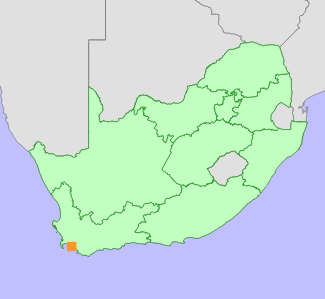|
Scientific Name | Protea stokoei E.Phillips |
Higher Classification | Dicotyledons |
Family | PROTEACEAE |
Common Names | Pink Sugarbush (e) |
National Status |
Status and Criteria | Endangered B1ab(ii,iii,iv,v)+2ab(ii,iii,iv,v) |
Assessment Date | 2019/09/26 |
Assessor(s) | A.G. Rebelo, H. Mtshali & D. Raimondo |
Justification | Protea stokoei has a restricted range, with an extent of occurrence (EOO) of 513 km², and an area of occupancy (AOO) of 124 km². It is known from five locations that are naturally fragmented. This slow-growing species continues to decline due to degradation of habitat by too frequent fires, alien plant invasions, and wild flower harvesting. It is therefore assessed as Endangered under criterion B. |
Distribution |
Endemism | South African endemic |
Provincial distribution | Western Cape |
Range | This species has a limited range in the Western Cape Province, South Africa where it occurs from the Hottentots Holland Mountains to Betty's Bay. |
Habitat and Ecology |
Major system | Terrestrial |
Major habitats | Kogelberg Sandstone Fynbos |
Description | It grows in moist, peaty montane soils on sandstone fynbos, at 900-1200 m. Mature individuals are killed by fires, and only seeds survive. Wind-dispersed seeds are stored in fire-resistant inflorescences, and released after fires. It is pollinated by birds. |
Threats |
| This species is threatened by too frequent fires, it has a long juvenile period taking up six to nine years to produce seed. Consequently it is limited to relatively fire-safe habitats such as rocky outcrops and steep slopes. Some colonies consisting of scattered plants have been eliminated from areas with a fire-rotation of less than nine years.
There has been a number of incidences of severe harvesting for the cut-flower industry reported. Another threat is competition from alien invasive plants that are spreading and increasing in density in parts of its range. |
Population |
Protea stokoei is found in stands of a few dozen plants, rarely several hundred. It is known from 16 subpopulations that are naturally fragmented, separated by several kilometres of deep valleys from their neighbours. Eight of these subpopulation have less than 150 plants. There is an ongoing slow population decline taking place due to habitat loss and degradation.
|
Population trend | Decreasing |
Conservation |
| This species has good protected area coverage with 80% of occupancy in Kogelberg, Hottentot's-Holland and Groenlandberg nature reserves. These protected areas are however not mitigating against the above listed threats. |
Assessment History |
Taxon assessed |
Status and Criteria |
Citation/Red List version | | Protea stokoei E.Phillips | EN B1ab(i,ii,iii,iv,v)+2ab(i,ii,iii,iv,v) | Raimondo et al. (2009) | |
Bibliography |
Goldblatt, P. and Manning, J.C. 2000. Cape Plants: A conspectus of the Cape Flora of South Africa. Strelitzia 9. National Botanical Institute, Cape Town.
Manning, J.C. and Goldblatt, P. 2012. Plants of the Greater Cape Floristic Region 1: The Core Cape Flora. Strelitzia 29. South African National Biodiversity Institute, Pretoria.
Raimondo, D., von Staden, L., Foden, W., Victor, J.E., Helme, N.A., Turner, R.C., Kamundi, D.A. and Manyama, P.A. 2009. Red List of South African Plants. Strelitzia 25. South African National Biodiversity Institute, Pretoria.
Rebelo, T. 2001. Sasol Proteas: A field guide to the proteas of southern Africa. (2nd ed.). Fernwood Press, Vlaeberg, Cape Town.
|
Citation |
| Rebelo, A.G., Mtshali, H. & Raimondo, D. 2019. Protea stokoei E.Phillips. National Assessment: Red List of South African Plants version 2024.1. Accessed on 2025/12/02 |
 Comment on this assessment
Comment on this assessment

